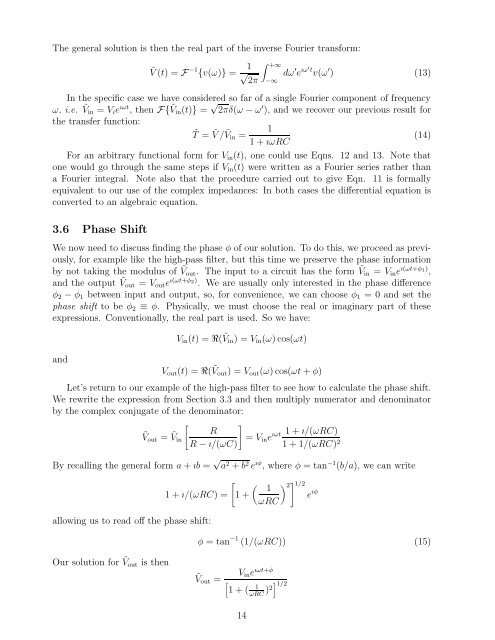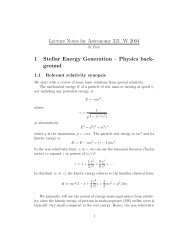Lecture Notes for Analog Electronics - The Electronic Universe ...
Lecture Notes for Analog Electronics - The Electronic Universe ...
Lecture Notes for Analog Electronics - The Electronic Universe ...
Create successful ePaper yourself
Turn your PDF publications into a flip-book with our unique Google optimized e-Paper software.
<strong>The</strong> general solution is then the real part of the inverse Fourier trans<strong>for</strong>m:<br />
˜V (t) =F −1 {v(ω)}= 1<br />
� +∞<br />
√ dω<br />
2π −∞<br />
′ e ıω′ t ′<br />
v(ω ) (13)<br />
In the specific case we have considered so far of a single Fourier component of frequency<br />
ω, i.e. ˜ Vin = Vie ıωt ,thenF{ ˜ Vin(t)} = √ 2πδ(ω − ω ′ ), and we recover our previous result <strong>for</strong><br />
the transfer function:<br />
˜T = ˜ V/ ˜ 1<br />
Vin =<br />
(14)<br />
1+ıωRC<br />
For an arbitrary functional <strong>for</strong>m <strong>for</strong> Vin(t), one could use Eqns. 12 and 13. Note that<br />
one would go through the same steps if Vin(t) werewrittenasaFourierseriesratherthan<br />
a Fourier integral. Note also that the procedure carried out to give Eqn. 11 is <strong>for</strong>mally<br />
equivalent to our use of the complex impedances: In both cases the differential equation is<br />
converted to an algebraic equation.<br />
3.6 Phase Shift<br />
We now need to discuss finding the phase φ of our solution. To do this, we proceed as previously,<br />
<strong>for</strong> example like the high-pass filter, but this time we preserve the phase in<strong>for</strong>mation<br />
by not taking the modulus of ˜ Vout. <strong>The</strong> input to a circuit has the <strong>for</strong>m ˜ Vin = Vine ı(ωt+φ1) ,<br />
and the output ˜ Vout = Voute ı(ωt+φ2) . We are usually only interested in the phase difference<br />
φ2 − φ1 between input and output, so, <strong>for</strong> convenience, we can choose φ1 =0andsetthe<br />
phase shift to be φ2 ≡ φ. Physically, we must choose the real or imaginary part of these<br />
expressions. Conventionally, the real part is used. So we have:<br />
Vin(t) =ℜ( ˜ Vin) =Vin(ω)cos(ωt)<br />
and<br />
Vout(t) =ℜ( ˜ Vout) =Vout(ω)cos(ωt + φ)<br />
Let’s return to our example of the high-pass filter to see how to calculate the phase shift.<br />
We rewrite the expression from Section 3.3 and then multiply numerator and denominator<br />
by the complex conjugate of the denominator:<br />
˜Vout = ˜ �<br />
�<br />
R<br />
Vin<br />
R − ı/(ωC)<br />
ıωt 1+ı/(ωRC)<br />
= Vine<br />
1+1/(ωRC) 2<br />
By recalling the general <strong>for</strong>m a + ıb = √ a 2 + b 2 e ıφ ,whereφ=tan −1 (b/a), we can write<br />
1+ı/(ωRC) =<br />
allowing us to read off the phase shift:<br />
Our solution <strong>for</strong> ˜ Vout is then<br />
�<br />
1+<br />
� �2 1<br />
ωRC<br />
�1/2 e ıφ<br />
φ =tan −1 (1/(ωRC)) (15)<br />
Vine<br />
˜Vout =<br />
ıωt+φ<br />
�<br />
1+( 1<br />
ωRC )2<br />
�1/2 14













